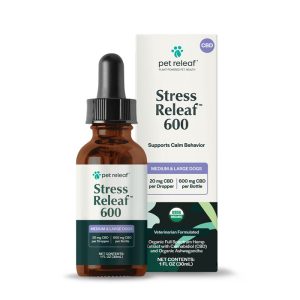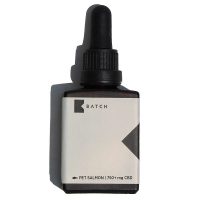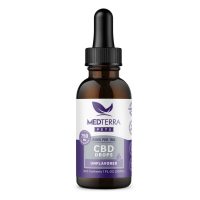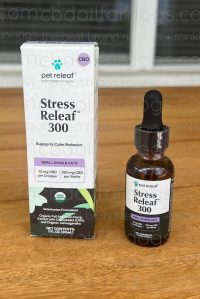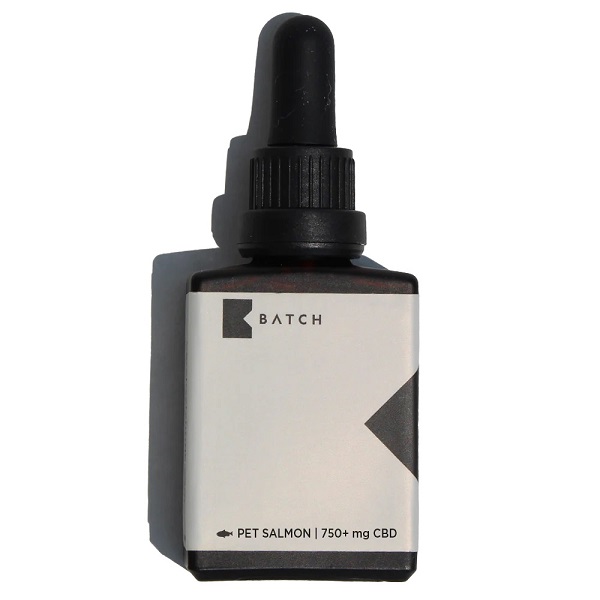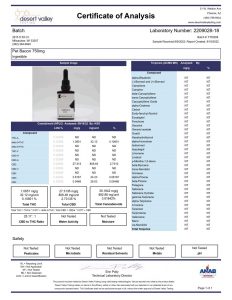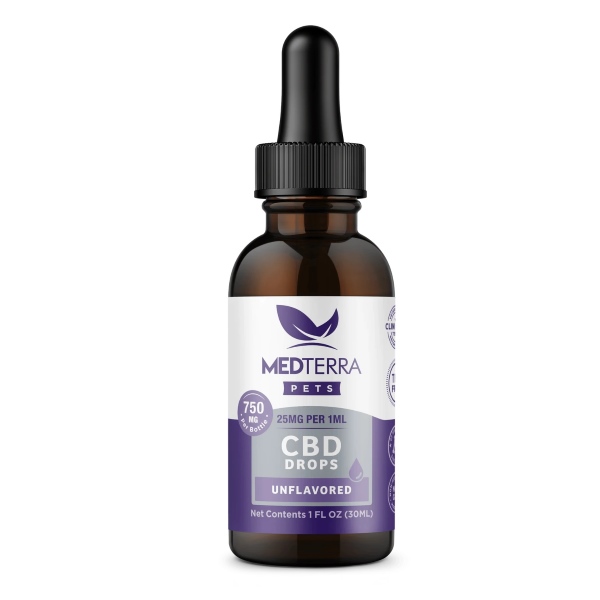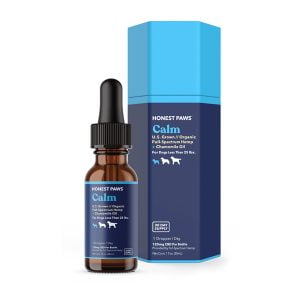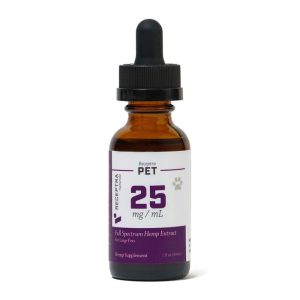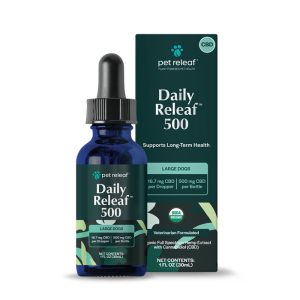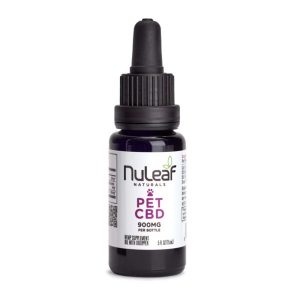Best CBD Oil for Dogs
March 11th, 2024 update
We’ve tested over 40 CBD oils from all the most popular brands using objective information like CBD lab reports, hemp sources and growing standards, safety tests, and unbiased customer opinions.
We explain each of these factors in detail, and where each product on this list ranks, so that you can feel confident and informed when choosing the best CBD oil for your dog.

Ranking factors (overview):
Points Scored
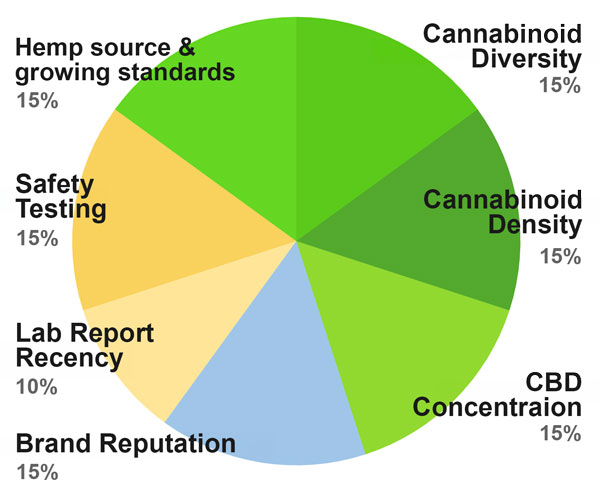
The 6 Best CBD Oils for Dogs in 2024
* best broad spectrum – effectiveness score takes cannabinoid profile into account, so this score will always be lower
** best isolate – effectiveness score takes cannabinoid profile into account, so this score will always be lower
Best Overall
Effectiveness Score: 9.7 / 10
- Cannabinoid Diversity: CBC, CBDa, CBDV, CBG, CBN, Δ9-THC
- Cannabinoid Density: +13%
- CBD Concentration: 110%
Transparency Score: 9.5 / 10
- Hemp Source: Colorado
- Growing Practices: USDA Certified Organic
- Safety Testing: Pass
- Lab Report Recency: July 2023
Reputation Score: 9.9 / 10
- Review Rating: 4.9 / 5
- # of Reviews: 593
- Money-back-guarantee: 30 days
What Stands Out
Honest Paws Mobility Oil is a top choice when we’re talking about CBD oil for dogs, and not just for mobility issues, but any kind of inflammatory problems. What makes it so special is the variety and amount of cannabinoids present in the oil.
Its 6 additional cannabinoids are second to only the brand’s Calm Oil (considered our best CBD oil for anxious dogs) in terms of variety, but boasts a higher total content of these compounds.
This mix gives dogs the fullest range of benefits possible, aiming to support everything from arthritis to general pain with the entourage effect.
Hemp quality and consistency is another big deal for Honest Paws. The CBD in its Mobility Oil, and all products, comes from USDA organic hemp grown in Colorado.
That state-specific source means greater consistency from batch to batch, an important aspect behind any health-related supplement.
This has led to pet owners’ trust this brand, and it shows in the reviews. With over 500 testimonials on its Google profile, averaging 4.9 out of 5 stars, people are talking about everything from how well the products work to the outstanding customer service.
Safety and testing are other key areas we focus on in our CBD for dog reviews, and Honest Paws doesn’t cut corners. They pass all the important safety tests and offer more lab reports than most, showing they’re serious about consistency and transparency.
Plus, the oil tastes good to dogs, thanks to organic MCT oil and the cold CO2 extraction process, making it easier to integrate into your dog’s routine.
Pricing is pretty reasonable, especially if you’re going for the 1000mg concentration, which offers the best value among our top 3 CBD oils for dogs. The smaller sizes do cost more per mg of CBD, so if you’re looking for a smaller, more budget-friendly option, you might glance at Lolahemp’s Hemp Oil for Pets.
An extra benefit that’s worth mentioning is the addition of organic turmeric, rich in curcuminoids, for enhanced anti-inflammatory effects.
And if you’re on the fence, Honest Paws offers a 30-day satisfaction guarantee, which really speaks to their confidence in the product’s effectiveness.
All-in-all, Honest Paws Mobility Oil is an excellent pick for any dog owner looking to support their pet’s mobility, ease pain, or just improve overall well-being.
With its impressive cannabinoid profile, commitment to safety, and additional health benefits, it’s a standout choice in the CBD market for dogs.
Runner Up
Effectiveness Score: 9.0 / 10
- Cannabinoid Diversity: CBC | CBDV | CBG | Δ9-THC
- Cannabinoid Density: + 11%
- CBD Concentration: 107%
Transparency Score: 9.4 / 10
- Hemp Source: USA
- Growing Practices: USDA Certified Organic
- Safety Testing: Pass
- Lab Report Recency: August 2023
Reputation Score: 9.5 / 10
- Review Rating: 4.7 / 5
- # of Reviews: 266
- Money-back-guarantee: 30 days
What Stands Out
Pet Releaf Stress Releaf combines quality, safety, and affordability, which is not always easy to find in a full-spectrum CBD pet oil.
It does not have the widest range of cannabinoids among our top contenders, but its 4 additional supportive cannabinoids bring 11% more cannabinoid content, on top of CBD.
Its hemp source is another plus. Pet Releaf uses USDA organic hemp, meeting some of the highest safety standards out there. It doesn’t specify where in the USA the hemp is grown, but knowing it’s USDA organic gives confidence in the product’s quality.
Taste and ingredients are important, too. The Stress Releaf 300 we tried was not only smooth but also subtly sweet, which should be appealing to most dogs.
The inclusion of ashwagandha is a thoughtful touch, offering added calming effects.
Pricing is also fair, sitting at $0.15 and $0.13 per mg of CBD for the 300mg and 600mg concentrations, respectively. This is a bit more expensive per mg than Honest Paws’ largest 1000mg concentration at $0.10 per mg, but offers good value for dogs not needing as much CBD.
Customer reviews are another area where Pet Releaf shines. The brand’s 4.7 out of 5-star rating from 266 Google reviews is a strong signal that it’s truly making a difference for pets and their owners.
In conclusion, Pet Releaf Stress Releaf stands out for its combination of USDA organic hemp and fair pricing. Although it does not boast the most complex cannabinoid profile, its quality, added ingredients for calming, and strong brand reputation make it stand out among other CBD oils for dogs.
Best CBD Oil for Small Dogs
Effectiveness Score: 9.5 / 10
- Cannabinoid Diversity: CBC | CBDa | CBDV | CBG | Δ9-THC
- Cannabinoid Density: + 22%
- CBD Concentration: 108%
Transparency Score: 8.7 / 10
- Hemp Source: USA
- Growing Practices: Organic
- Safety Testing: Pass
- Lab Report Recency: October 2023
Reputation Score: 7.5 / 10
- Review Rating: 4.9 / 5
- # of Reviews: 19
- Money-back-guarantee: 30 days
What Stands Out
Lolahemp Hemp Oil for Pets is a CBD oil that finds a sweet spot between potency and affordability, particularly in its lower concentrations.
What stands out with Lolahemp is its cannabinoid richness, which includes 5 additional supportive cannabinoids that total 22% more cannabinoid content on top of the CBD.
The hemp used in this product is organically grown in the USA. While it doesn’t boast the state-specific sourcing some other products do, the commitment to using organically grown hemp is a big plus, ensuring a cleaner, safer product for your dog.
As far as pricing, Lolahemp stands out with its smaller 150mg tincture, priced at $0.20 per mg of CBD. This is on par with the $0.21 for Honest Paws 250mg tincture, but much less than the $0.34 for HP’s 125mg oil.
Taste is an important consideration, and the MCT carrier oil used in Lolahemp’s oil helps make it smoother and more palatable.
Despite having fewer reviews than some bigger names like Honest Paws or Pet Releaf, Lolahemp still boasts a strong 4.9 out of 5 stars rating from 25 Google reviews, instilling some level of added confidence in its products.
In conclusion, Lolahemp Hemp Oil for Pets presents a compelling option for pet owners seeking a safe, good quality full-spectrum oil, especially for owners of small dogs looking for a budget-friendly introduction to CBD.
Best CBD Dog Treats
Effectiveness Score: 8.6 / 10
- Cannabinoid Diversity: CBC, CBDV, CBG, Δ9-THC
- Cannabinoid Density: +10%
- CBD Concentration: 134%
Transparency Score: 9.6 / 10
- Hemp Source: Colorado
- Growing Practices: USDA Certified Organic
- Safety Testing: Pass
- Lab Report Recency: February 2024
Reputation Score: 9.9 / 10
- Review Rating: 4.9 / 5
- # of Reviews: 593
- Money-back-guarantee: 30 days
What Stands Out
Like its CBD oil line, Honest Paws Calm Bites are made with the same Colorado grown, USDA organic hemp that is rich in CBD and other cannabinoids.
Its very recent CBD lab report that was conducted in February of this year showed CBC, CBDV, CBG, and trace amounts of THC (0.002%), tying it for having the most supportive cannabinoids among CBD dog treats.
This lab report also showed that no harmful toxins such as heavy metals or pesticides were detected.
While CBD oils are considered more effective due to CBD’s higher bio-availability (the body’s ability to absorb it) when taken with a fatty substance, Honest Paws Calm Bites overcomes this hurdle by including organic coconut oil, organic MCT oil, and organic peanut butter for better absorption.
The remaining ingredients include organic barley flour, organic gum Arabic, and organic oat flour. Not only do these use the best CBD extract, but with just 7 all-natural ingredients in these treats, they are the healthiest chews we have reviewed.
With anecdotal evidence ranging from improvements in social and separation anxiety, hyperactivity, and general calmness during car rides or crate training, we highly recommend Honest Paws Calm Bites to anyone looking for the best CBD dog treats available.
The combination of top-grade CBD and all-organic ingredients makes Honest Paws so confident that you and your dog will love them that they offer a 30-day money back guarantee after trying their products out.
If you decide these treats are right for your dogs, feel free to use to coupon code COFD at checkout or use this link for 20% off your first order.
If you would like to see more options, you can also check out our complete CBD dog treat reviews here.
Best Broad-Spectrum CBD Oil for Dogs
Effectiveness Score: 7.0 / 10
- Cannabinoid Diversity: CBC | CBDV | CBG | CBN | Δ9-THC
- Cannabinoid Density: + 5%
- CBD Concentration: 105%
Transparency Score: 9.6 / 10
- Hemp Source: Wisconsin
- Growing Practices: Organic
- Safety Testing: Pass
- Lab Report Recency: December 2023
Reputation Score: 8.9 / 10
- Review Rating: 4.9 / 5
- # of Reviews: 76
- Money-back-guarantee: No, only if unopened
What Stands Out
Batch comes in as the first human-focused brand on this list, which happens to offer a great CBD pet oil too.
What’s most unique about Batch Pet CBD Oil Tincture is that it uses an ethanol extraction method compared to the more conventional CO2 extraction method.
This allows Batch to preserve more terpenes and cannabinoids, but comes with a more bitter taste and a less consistent cannabinoid profile between batches.
This is why the Batch adds natural flavoring to their pet oils, in the form of a bacon, chicken, and salmon flavored option.
To put all of this into broader context, what stands out about Batch’s Pet CBD Oil is its solid quality-price ratio for their largest size. Their 1500 mg CBD concentration, which is priced at just $0.06 per mg of CBD, offers an above average THC-free product for a below average price.
Best Isolate CBD Oil for Dogs
Effectiveness Score: 4.3 / 10
- Cannabinoid Diversity: CBDV
- Cannabinoid Density: + 0%
- CBD Concentration: 106%
Transparency Score: 7.3 / 10
- Hemp Source: unspecified
- Growing Practices: Organic
- Lab Report Recency: October 2023
Reputation Score: 8.7 / 10
- Review Rating: 4.2 / 5
- # of Reviews: 366
- Money-back-guarantee: No
What Stands Out
Medterra CBD Pet Oil is considered an isolate CBD, meaning it contains only CBD (or in this case, CBDV too, a variation to CBD).
What separates Medterra’s CBD isolate oil for dogs lies in the brand’s reputation and transparency.
One advantage for brands selling isolate CBD is its low cost. Extracted only CBD means cheaper extraction methods are used, as they don’t need to preserve the other beneficial cannabinoids in the process. Many, too, use imported CBD isolate which are not grown with the stricter US growing standards.
In Medterra’s case, they do specify the use of organic hemp, but do not disclose where the hemp was grown.
While it has good reviews, many of these come from their human-line of CBD oils, which are available in the form of broad spectrum CBD in addition to isolate.
It is also worth noting that Medterra is the only product on this list that does not come with a money-back guarantee, similar to most isolates.
Nonetheless, if you are specifically looking for a standalone CBD product, Medterra CBD Pet Oil is our recommended choice.
What size CBD oil should I buy?
Most pet CBD brands offer products in several sizes to help owners get the best value for their dog’s needs. Because CBD dosages are calculated by weight, bigger dogs often need a lot more CBD oil than smaller breeds.
Pups with chronic conditions, such as recurrent seizures, may also need larger daily dosages than dogs with infrequent issues like phobias, who might only take CBD once every few months.
Owners of large dogs or dogs with ongoing conditions should look at high-concentration CBD oils. While they are more expensive than smaller-sized products, they usually offer a lower cost per mg of CBD, meaning that you’ll save money in the long run.
For more, see our full CBD for dogs dosing guide here.
CBD oil versus CBD dog treats
We generally recommend CBD oils over CBD treats for two reasons.
First, consuming CBD alongside high-fat foods can increase absorption into the body by up to four times.
Second, because CBD oils are more versatile than treats. Owners can decide exactly how much CBD their dog should get, and add it to their pup’s favorite foods, treats, or directly into their mouths.
CBD treats do have their benefits, though. Many owners prefer the convenience of a pre-made snack, and infusing CBD directly into foods can help reduce any strong plant flavors.
Where to buy CBD oil for dogs
In the USA, you can buy CBD oil for dogs at various places, both online and in physical stores. Some options are better than others, however, which are listed below:
- Online CBD retailers (Yes): There are many online shops that specialize in CBD products for pets, such as Honest Paws, Pet Releaf, or Lolahemp, that offer a wide range of CBD products, including oils, treats, and topicals specifically designed for dogs. The advantages of buying directly from a brands website are (1) more knowledgeable sales support, (2) subscription services that offer a reoccurring discount on every order, (3) greater selection than physical stores, (4) some brands will offer a 30-day satisfaction guarantee or your money back, and (5) the convenience of ordering from home.
- Pet supply stores (Limited): Many pet supply stores, such as Petco or PetSmart, carry CBD oil for dogs. You can find these products in the supplement or pet health section of the store, but they will only carry a fraction of the options that you can find from online brands directly.
- Local pet stores (Maybe): Some independent pet stores may also carry CBD oil for dogs. It’s a good idea to call ahead and ask if they have it in stock.
- Veterinarian clinics (Unlikely): While more vets are discussing CBD oil for dogs, they typically do not sell CBD. It’s best to ask your local veterinarian if they carry it, and/or if they carry the specific product you are looking for.
- Amazon (NO): Amazon bans the sale of CBD oil for both humans and animals on its marketplace, as outline in its Seller rules and guidelines. This doesn’t stop huge numbers of sellers from attempting to do so anyway—a simple search for ‘CBD’ brings up thousands of results.
Most of these don’t actually include CBD, or hide unknown quantities of CBD in products labeled as ‘Hemp oil’ or ‘anxiety oil’. Using these products on your dog is not recommended. While it’s possible that you will end up with a genuine CBD product, the black market nature of Amazon’s CBD marketplace makes it hard, if not impossible to tell where these products are from and how they’re made.
What’s the difference between full-spectrum, broad-spectrum, and isolate CBD oil?
- Full-spectrum CBD is an unprocessed, whole-plant extract. It contains CBD, THC, and the other cannabinoids present in the hemp plant.
- Broad-spectrum CBD is a hemp extract that’s been processed to remove certain cannabinoids, notably THC, but contain at least one other cannabinoid in addition to CBD.
- Isolate CBD is a hemp extract that’s been extensively processed to produce a CBD powder, containing no other cannabinoids.
Note: Pet-safe CBD derived from hemp contains minimal THC (0.3% or less), posing no risk of intoxication. Always buy from a reputable brand and check their Certificate of Analysis (COA) to ensure THC levels are below 0.3%.
To give your dog the highest chance of feeling better, we recommend full-spectrum CBD oils, as they provide the full benefits of hemp.
Other cannabinoids like CBG, CBN, and CBDV have been shown in clinical studies to offer their own supportive qualities, and can enhance CBD’s effectiveness, a term coined “the entourage effect”.
The entourage effect suggests that cannabis compounds work synergistically, and are most effective when consumed in their natural form and ratios. When an oil contains a diverse range of cannabis compounds, dogs may feel more benefits than when supplementing with broad-spectrum or isolate CBD.
But no two hemp strains have the same combination of cannabis compounds. As a result, two similar-looking full-spectrum CBD products may contain very different CBD extracts.
The best way to see exactly what’s inside a CBD extract is to read a product’s certificate of analysis, which is compiled by a third-party lab.
How do I give my dog CBD
There are 4 commonly discussed methods for giving your dog CBD: mixing it into their food, directly into their mouth, rubbing it onto their gums, or giving them a CBD-infused treat.
We recommend adding it to their food, as a study involving 12 dogs with chronic conditions found no significant absorption difference between adding CBD to food and applying it directly to the gums.
CBD oils are favored over treats or creams due to their efficacy, versatility, and cost-effectiveness. Their high-fat carrier oils increase the bioavailability of CBD, meaning higher CBD absorption. Oils also allow for flexible dosing, essential for adjusting to each dog’s specific needs.
While CBD treats offer a solution for finicky eaters and are handy for on-the-go dosing, they may not match the dosing precision of oils.
Topical CBD products, like creams and balms, are beneficial for localized issues but do not provide systemic anti-inflammatory effects.
Disclaimer:
When products are purchased through our site, we may receive a commission. Always check manufacturer websites for the most up-to-date information. All our product recommendations are based on our experts’ opinions and thorough consumer research, including our list of best CBD oils for dogs in 2024.



